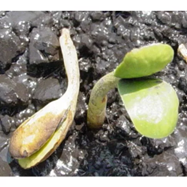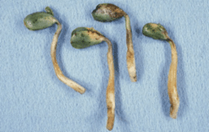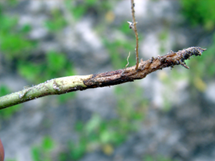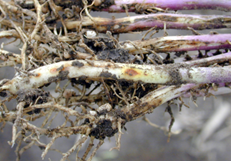It is well known that continuous cultivation of the same crop on the same soil leads to “tired” or “sick soil”, with consequent reduction in yields over time. However, this does not happen to the same extent for all crops, nor is it always due to the same cause. In the summer sowing areas, the producer does not have many alternatives at his disposal, but in most cases, crop rotation is practiced with maize, soybeans and sunflower. In some cases, peanuts, dry beans and even cotton are also used as alternative crops.
Seedling wilt or root rot is probably one of the most underestimated diseases in the summer sowing areas in South Africa. Mainly because many of the symptoms occur below the soil surface and when they are noticed above ground, it is already too late. Root rot and seedling wilt are caused by a variety of fungi and can rarely be attributed to a single cause, so we refer to it as a root disease complex.
In summer row crops, poor condition is usually attributed to environmental factors or poor seed quality. Too often a farmer can completely forget what the symptoms and environmental conditions were that prevailed during seedling development, due to being too rushed during planting and forget that there is something such as soil fungi. Little research is done, and little is understood, partly due to the difficult integrated soil and root disease complex. As mentioned, seedling wilting symptoms are not necessarily the final stage of root diseases, on the contrary, they may be the primary source of infection that is later identified as crown and stem rot.
Root rot, Crown rot and Seedling wilt Damping-off
Seedling wilt is the term used to describe rot of young seedlings directly on, or just above, the soil surface. In most cases it is accompanied by rotten, soft, slimy stems. Small seedlings above the soil surface wither away and disappear. The same fungi that cause seedling wilt, stem damage and lesions are usually also those that cause root rot.
The most common root fungal diseases or seedling wilt diseases we are dealing with are Pythium seedling wilt, Rhizoctonia root rot and Fusarium root rot.
Pythium
Attacks many young seedlings. Attack the stem, moving upwards as far as the cotyledons. It is a parasitic fungus and can attack many different tumours. In the presence of moisture, Pythium spreads rapidly through different types of soil.
Phytophthora
Attack young seedlings such as Pythium, usually together in a complex. However, phytophthora is much more active and more aggressive. Can basically attack any crop.
Fusarium
Is associated with a light to dark pink discoloration of the inner layers of the rotten material, especially the roots. Fusarium wilt is usually secondary to other parasitic fungi. Fusarium is a weaker type of parasitic fungus that usually follows other fungi or attacks material that has already been weakened by other fungi.
Rhizoctonia
There is clear rot of the stem just above the soil surface, the lesions are first grey and watery, then it dries out quickly, browns and sinks.
Other soil-borne fungi include Exserohilum, Aspergillus, Penicilium and Trichoderma. The degree of infection can vary between soil types (in terms of clay percentage), soil temperatures, liming, soil fertility status and overall soil health. The different fungi can differ from each other in their preference for environmental conditions (moisture and temperature) and the crop host (according to van Rensburg, ARC Grain Crops, Potchefstroom).
The type of disease differs with respect to the host and genotype, environmental factors, and the preceding crop. Different fungi or pathogens causing varying intensity of the disease.
Factors that determine root diseases
The intensity with which root diseases affect the host is determined by:
- Plant depth
- Soil structure
- Seed quality
- Mechanical seed coat damage
- Insect nutrition
- Genetic resistance
- Environmental conditions
Yield losses
It is extremely difficult to determine yield losses of the young infected seedling. What also makes it difficult is to simulate field conditions in the greenhouse. It is difficult to simulate field symptoms on lands present under different environmental conditions within controlled conditions. The variation is just too much in the disease complex, and doing good research on the disease complex is extremely difficult. Collected fungi usually consist of a complex of causative and secondary pathogens. By the time plant tissue is degraded, more saprophytic fungi and bacteria are present, and it is nearly impossible to identify the primary disease-causing fungus.
It is extremely difficult to determine yield losses of the young infected seedling. What also makes it difficult is to simulate field conditions in the greenhouse. It is difficult to simulate field symptoms on lands present under different environmental conditions within controlled conditions. The variation is just too much in the disease complex, and doing good research on the disease complex is extremely difficult. Collected fungi usually consist of a complex of causative and secondary pathogens. By the time plant tissue is degraded, more saprophytic fungi and bacteria are present, and it is nearly impossible to identify the primary disease-causing fungus.
To determine yield losses, it can be assumed that seedlings that do not develop into mature plants have a loss, so there are fewer plants that can contribute to the final harvest. If root diseases lead to crown and stem rot, the infected plants will not reach their full genetic potential due to poorly developed root system which impedes water and nutrient uptake. Weakened trunks also lead to falls and trunk cracks that hinder the harvesting process.
Root diseases
1. Pythium – maize
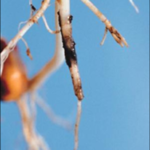
Symptoms:
- Most common disease, associated with young seedlings and seedling root diseases
- Dark discoloration and slimy mesocotyl that shrinks away
- Outer wall of root is rotten while inside shows no symptoms
- The cortex (outer layer) will come off if the root is pulled between your fingers
- May cause seed rot before germination, but usually infects seedlings just after emergence
Environment:
- Cool wet soils, especially low-lying and poorly drained areas
- Critical factor – excess moisture (water), waterlogging conditions regardless of temperature
2. Fusarium – maize
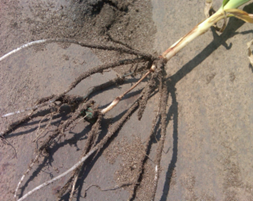
Symptoms:
- Auburn lesions on the roots or mesocotyl
- Mesocotyl shrinks away
- On older plant roots, the lesions are darker in color and roots that rot completely.
Environment:
- Fusarium occurs under a wide range of temperatures and humidity conditions. It usually occers when plants experienced stress such as compaction, cold shock or waterlogging.
- The intensity of the disease increases as stress conditions increase.
- Insect-eating damage to the roots causes the disease to move up to the crown and base of the plant.
- Late infection causes stem rot after pollination and grain filling.
3. Rhizoctonia – maize
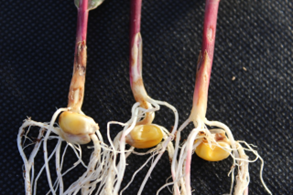
Symptoms:
- Initial symptoms include brown lesions on the roots and mesocotyledonous
- Submerged lesions and rotten roots
- Most recognizable symptoms are reddish-brown sunken cancers on the roots, crown and especially the tap roots of older plants
- Plants may be dwarfed, but usually no above-ground symptoms visible
Environment:
- Disease is more common under irrigation
- Can infect roots between 8-28⁰C
- Mature plants can fall over due to poor or no root development
4. Pythium – soybean
Symptoms:
- Pythium attacks seed before and just after germination
- Seeds are soft and rotten with soil particles clinging to the seeds
- Seedling wilt is associated with the hypocotyl that narrows (strangles) and then dies suddenly
- During emergence, young seedlings die off before the first leaves form
- Pythium plants pull out of the soil easily, because all the roots have rotted off
Environment:
- Prefers temperatures below 15⁰C, on early plantings may be the first disease that will infect soybeans
- No-till lands with a lot of residue, compacted soils with moisture and cool temperatures will most likely be Pythium infected.
5. Rhizoctonia – soybean
Symptoms:
- Plants are dwarfed and over time they die above ground
- Brown lesions on the roots and mesocotyledonous
- The sunken lesions appear to be the outside of the epidermis, exposing only the internal part of the stem or root
Environment:
- Disease is more common especially on sands and in the presence of high soil surface temperatures
- Can infect roots between 8-28⁰C
- Mature plants can fall over due to poor or no root development
6. Fusarium – soybean
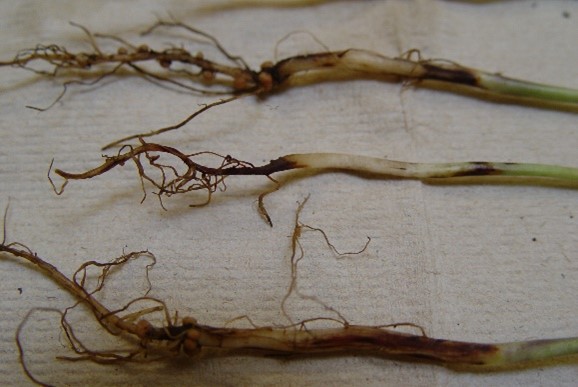
Symptoms:
- Poor germination and poor vigor
- Mostly dwarfed plants
- Upper leaves wither, a fall off
- Brown discoloration of vascular bundles in the stems
- Rotting of stems is not visible above ground
Control measures:
- Crop rotation
- Genetics – there is no total resistance, but tolerances differ
- Chemical and biological control – seed applied fungicides, even if only for the first few weeks
- Preventative management not corrective
- Well-drained soils
Sources:
Various articles: Dr.B. Jansen van Rensburg, ARC – Cereals, Potchefstroom.
Pioneer Hi-Bred: Field Facts, Crop Insights, Crop Focus
For more information go to www.pioneer.com/za or send an email to info.rsa@pioneer.com

